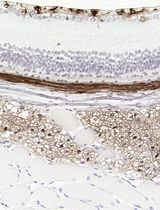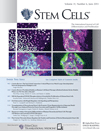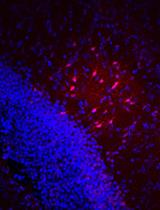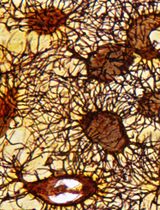- EN - English
- CN - 中文
Alkaline Phosphatase Staining
碱性磷酸酶染色
发布: 2014年03月05日第4卷第5期 DOI: 10.21769/BioProtoc.1060 浏览次数: 30588
评审: Anonymous reviewer(s)

相关实验方案

采用 Davidson 固定液和黑色素漂白法优化小鼠眼组织切片的免疫组化染色
Anne Nathalie Longakit [...] Catherine D. Van Raamsdonk
2025年11月20日 808 阅读
Abstract
Two main features characterize pluripotent cells; self-renewal (unlimited cell division) and the ability to give rise to all cells of the adult organism. Given the recent impact of induced pluripotent stem cells (iPSCs) and ongoing use of pluripotent embryonic stem cells ESCs (ESCs) in basic discovery, drug development, and potential use for stem cell therapy and regenerative medicine, methods to definitively distinguish pluripotent cells from their differentiated derivatives are required. This will allow us to better understand the factors that promote their survival, self-renewal, and lineage-specific differentiation.
Undifferentiated embryonic stem cells (ESCs) and induced pluripotent stem cells (iPSCs) may be identified through the use of biomarker and functional assays. Biomarker assays include those for transcript and protein expression of important pluripotency transcription factors (OCT4, SOX2, and NANOG), cell surface markers (SSEA-1, -3, and -4; TRA-1-60, TRA-1-81), and Alkaline Phosphatase (AP) activity (Brambrink et.al., 2008; Ginis et al., 2004). Functional assays include: (1) the ability to generate teratomas consisting of cells from all three germ layers (endoderm, ectoderm, and mesoderm) when transplanted into immunodeficient mice or upon in vitro differentiation; (2) the ability to generate a chimera; and (3) germline transmission (Marti et al., 2013; Buehr et al., 2008). The latter two tests are ethically feasible only for mouse and other non-human pluripotent cells.
In this protocol (Campbell and Rudnicki, 2013) we describe a rapid method to screen for pluripotent cells by AP activity. AP, also known as Basic Phosphatase catalyzes the dephosphorylation of many molecules including nucleotides and proteins. AP activity is high in pluripotent cells but is greatly decreased in more differentiated cell types. The technique described herein may be used to enumerate pluripotent cells during differentiation in the presence or absence of specific genetic manipulations or small chemical modulators. It may also be used to monitor induced pluripotency using defined factors from more differentiated cell types.
Materials and Reagents
- Mouse ESCs (mESCs)
- 0.1% gelatin (Sigma-Aldrich, catalog number: G1393 )
- Murine embryonic fibroblast (MEF) feeder cells
- Alkaline Phosphatase Staining Kit (Stemgent, catalog number: 00-0009 )
- Fixation Solution
- AP Staining Solution A
- AP Staining Solution B
- Fixation Solution
- 1x PBS (see Recipes)
- 1x PBS-T (see Recipes)
- 1x PBS-glycerol (see Recipes)
Equipment
- 6-well plate or 24-well plate
- Aluminum foil
- Light microscope with 10x objective
Procedure
文章信息
版权信息
© 2014 The Authors; exclusive licensee Bio-protocol LLC.
如何引用
Campbell, P. A. (2014). Alkaline Phosphatase Staining . Bio-protocol 4(5): e1060. DOI: 10.21769/BioProtoc.1060.
分类
干细胞 > 胚胎干细胞 > 细胞染色
细胞生物学 > 细胞染色 > 全细胞
您对这篇实验方法有问题吗?
在此处发布您的问题,我们将邀请本文作者来回答。同时,我们会将您的问题发布到Bio-protocol Exchange,以便寻求社区成员的帮助。
提问指南
+ 问题描述
写下详细的问题描述,包括所有有助于他人回答您问题的信息(例如实验过程、条件和相关图像等)。
Share
Bluesky
X
Copy link










